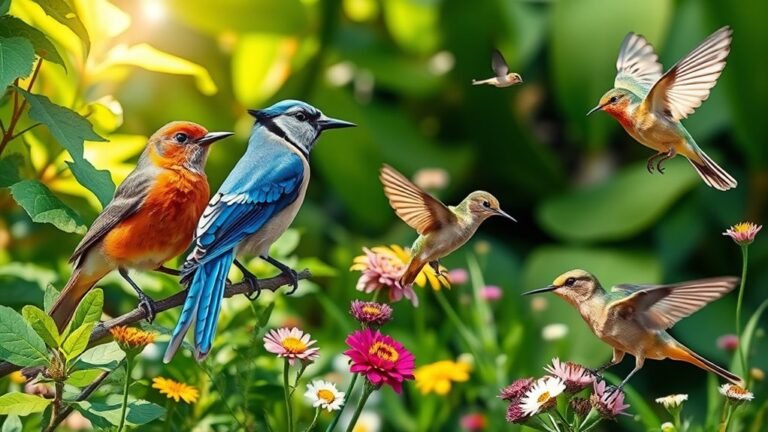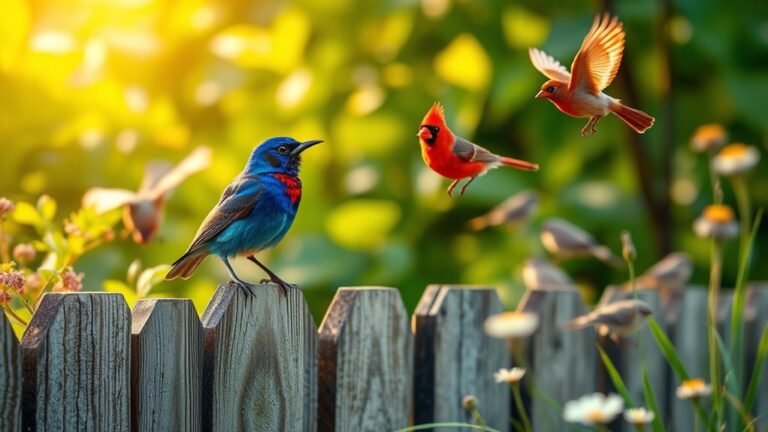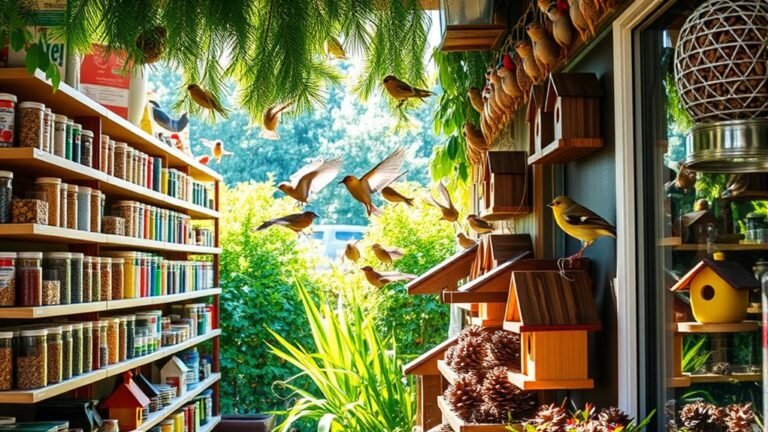Brown Birds With a Touch of Red on Their Heads
As you watch birds, you may see some brown birds with bright red on their heads. Species like the Cassin's Finch and the Ruby-Crowned Kinglet stand out because of this unique coloring. These birds have special traits that help them survive in their habitats. Their behaviors can give us clues about how they find mates and defend their territories. Understanding these colorful markings can deepen your knowledge of bird interactions.
Key Takeaways
- The Cassin's Finch features a bright red head, often seen in wooded mountain habitats, and is primarily seed and bud eaters.
- The Brown-Headed Cowbird has a brown plumage with a slight reddish tinge on the head, known for its brood parasitism behavior.
- Male Pine Grosbeaks display a reddish crown against their brown bodies, foraging in groups for seeds and berries in forested areas.
- Red-Headed Woodpeckers exhibit a distinct red head along with their black and white bodies, using drumming for communication and territory marking.
- The Ruby-Crowned Kinglet has a small red crown that is often hidden, known for its high-pitched songs and long-distance migration skills.
The Scarlet Tanager: A Vibrant Songbird

The Scarlet Tanager is a beautiful songbird known for its bright red feathers and black wings. Birdwatchers often admire its striking appearance.
These birds like mixed or deciduous forests that have plenty of trees and plants. They produce a series of pleasant sounds that attract attention in their habitats and among birdwatchers. You can often hear them singing from high branches, displaying their vibrant hues.
Watching the Scarlet Tanager connects you to nature. You can appreciate its smooth movements and melodic calls. Knowing where these birds prefer to live can help you find them, enhancing your birdwatching experience and understanding their importance in the environment.
The Red-Headed Woodpecker: A Master of Drumming
Every day, you can hear the sharp drumming of the Red-Headed Woodpecker in forests and parks. This bird displays fascinating woodpecker behavior, especially with its drumming.
These sounds help mark territory and attract mates.
Here are four important points about their drumming:
- Rhythm Variation: They use different rhythms to create distinct patterns that catch your ear.
- Location Choice: They often drum on dead trees to enhance sound.
- Frequent Drumming: These woodpeckers can drum up to 20 times in a single second.
- Communication: Their drumming sends important messages to other woodpeckers.
Watching them can give you insight into their daily lives.
The Common Redpoll: A Cold-Weather Forager

Red-Headed Woodpeckers are known for their loud drumming, but another interesting bird thrives in cold weather: the Common Redpoll.
These small birds have unique foraging skills that help them survive in winter, where food is hard to find. You can often see them hopping around as they pull seeds from birch and willow catkins.
They've adapted to the cold by finding food even when it's buried under snow. Common Redpolls like to forage in groups. This social behavior increases their chances of discovering hidden food.
Watching them move quickly and noticing their bright colors can inspire a greater appreciation for these hardy birds and highlight the important connections in nature.
The Brown-Headed Cowbird: A Unique Parasitic Nest User
Brown-Headed Cowbirds display unique behaviors that highlight brood parasitism among birds. Instead of building their own nests, they utilize the nests of other bird species.
Here are the key points:
- They lay their eggs in the nests of smaller birds. The host birds then raise the cowbird chicks without knowing.
- Cowbird chicks typically hatch first and grow faster than the host's chicks, giving them an advantage.
- This behavior can affect the populations and nesting success of host birds.
- Cowbirds adapt to different environments, showing their ability to thrive.
These behaviors illustrate important interactions in ecosystems. They show the cleverness of cowbirds and the effects of their strategies on other species.
The House Finch: Urban Dwellers With Colorful Crowns

Have you seen the bright red and orange feathers on the House Finch against their brown wings? These birds adapt well to city life.
You can find them sitting on streetlights or moving between balconies, showing their cleverness. They like to nest in urban areas, often using shrubs or building ledges.
Male House Finches sing beautifully and display their colorful feathers to attract females. Their cheerful presence adds to the city environment, creating connections amid the busyness.
Enjoy watching these delightful finches as they thrive in our urban landscapes.
The Red-Crested Cardinal: An Exotic Intruder
The Red-Crested Cardinal has a bright red head and a brown body. This bird shows how species can thrive in new environments.
Although it's originally from South America, you can find it in many places across the world. Its preferred habitats include:
- Parks and gardens
- Wetlands and riverbanks
- Urban areas
- Coastal regions
These environments allow the Red-Crested Cardinal to interact with local birds, forming a unique mix of species.
Watching this vibrant bird can help you appreciate how adaptable birds are. They can settle in both natural and man-made spaces.
This highlights the connection we share with nature and the diverse life around us.
The Ruby-Crowned Kinglet: The Tiny Marvel of Migration
The Ruby-Crowned Kinglet is a small bird with impressive skills for migrating. It travels long distances, sometimes hundreds of miles, to find suitable habitats.
This bird primarily eats insects, which are crucial for surviving winter months. During breeding season, Ruby-Crowned Kinglets prefer to nest in dense shrubs, making them hard to spot.
Their songs consist of high-pitched notes that are often heard, alerting others to their location. Currently, their conservation status remains stable because they can adapt to different environments.
Understanding where they live helps people connect with these fascinating birds.
The Pine Grosbeak: A Gentle Giant of the Forest
The Pine Grosbeak is a notable bird found in northern forests. Its bright colors and calm behavior make it easy to recognize. You can see Pine Grosbeaks in coniferous areas.
Observing them provides insight into their habits:
- They forage together in groups, eating berries and seeds.
- Pine Grosbeaks remain calm and don't scare easily.
- Their soft calls create a pleasant sound in the forest.
- They're well-suited for winter, showing their ability to adapt.
Learning about their habitat and behavior helps us understand the Pine Grosbeak's part in nature.
Whether you're hiking in snowy forests or enjoying the outdoors, keep an eye out for this gentle bird. It adds a sense of peace to any natural setting.
The Red-Tailed Hawk: Majestic Predator of the Skies
Seeing a Red-Tailed Hawk flying high above open fields or resting on a tree branch is truly impressive.
These birds have excellent hunting skills. They use sharp vision and strong talons to catch small mammals. They migrate long distances from breeding to wintering areas.
Red-Tailed Hawks build large nests from sticks in tall trees. They prefer habitats like open fields and forests. They adapt well to different environments. Their conservation status is stable.
During mating season, they make loud calls to mark their territory. They're protective of their nests, ensuring the safety of their young.
Watching these hawks is a rewarding experience for nature lovers.
The Cassin's Finch: A Feathered Friend of the High Altitude
As you hike in high-altitude areas, you may spot the Cassin's Finch. This small bird is known for its bright red head and pleasant song. It lives in mountainous regions, moving among coniferous trees.
When you watch the Cassin's Finch, you'll notice:
- Habitat: It prefers wooded areas on mountain slopes.
- Diet: It eats seeds, buds, and insects.
- Social Nature: It often travels in small groups, which creates a sense of community.
- Breeding: It builds its nest in conifer trees, which offers safety from predators.
Knowing these features of the Cassin's Finch can enhance your connection to nature.
This bird reminds us of the beauty and sounds of the high-altitude environment.
Frequently Asked Questions
What Habitats Do Brown Birds With Red Heads Prefer?
Brown birds with red heads thrive in various habitats. They prefer wooded areas and open fields. These birds often nest in trees and shrubs, which meet their breeding and feeding needs effectively.
How Can I Attract These Birds to My Garden?
To attract birds to your garden, place bird feeders filled with sunflower seeds nearby. Add nesting materials like twigs and dried grasses to encourage them to stay. This helps create a lively atmosphere and a connection with nature. Birds will appreciate the food and shelter, making your garden a welcoming space for them. Enjoy watching the vibrant life they bring!
What Do Brown Birds With Red Heads Typically Eat?
Brown birds with red heads usually eat seeds, fruits, and insects. They often enjoy sunflower seeds and berries. By providing these foods in your garden, you can attract these birds and create a friendly environment for them.
Are Any of These Birds Endangered or Threatened?
Some brown birds with red heads are endangered. Conservation efforts aim to protect their habitats. These actions help the birds thrive and support biodiversity, enriching our connection to nature.
How Can I Identify These Birds by Their Calls?
To identify birds by their calls, pay attention to the call's pitch and rhythm. Listen carefully to each bird's sound. Unique patterns can help you tell different species apart and increase your enjoyment of their calls. Focus on these characteristics to improve your birdwatching experience.

Hello, I’m Amelia White, the founder of birdsfanatic.com. As a lifelong bird enthusiast and spiritual seeker, I’ve always been fascinated by the mystical connections between birds and the human experience. On this site, I share my knowledge and insights into the symbolic meanings and spiritual significance of various bird species, exploring their roles in mythology, folklore, and cultural traditions. Join me on this journey into the world of birds, where we’ll discover the hidden wisdom and guidance that these magnificent creatures have to offer.







